With the Bordeaux 2019 en primeur campaign now behind us, Part I of Wine Lister’s 2020 Bordeaux Study examines the results of our latest in-depth trade survey. Answered by 50 key players across major fine wine markets, the results provide insight into the wine trade’s latest position on the region, including its level of confidence in specific wines.
The trade’s faith in Bordeaux brands has increased on the whole since last year, with more Bordeaux wines moving up in their confidence rating than down. For the fourth consecutive year, no Bordeaux wine received a confidence rating of 10/10. Brands that have retained their 9/10 confidence rating since last year are Lafleur, Le Pin, Margaux, Mouton, Petrus, and Vieux Châteaux Certan.
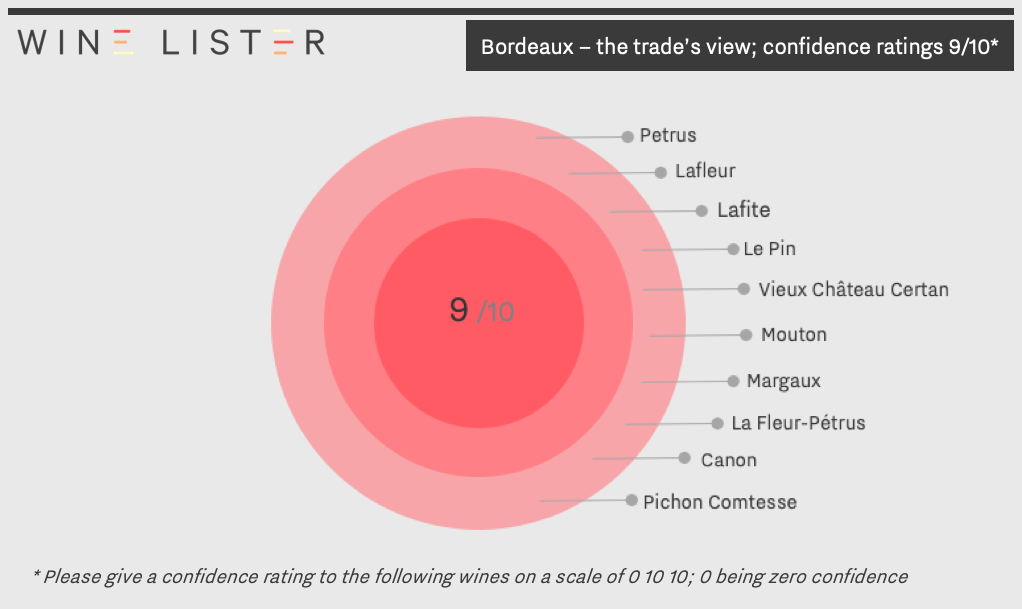
Joining them in 2020 are Canon, La Fleur-Pétrus, Lafite, and Pichon Comtesse, while Latour has moved down a rating since last year, to 8/10. The survey was, however, conducted prior to the first growth’s successful 2012 release (27th May) at c.£350 per bottle, marking its first release of a vintage exclusively as mature stock.
There are 28 Bordeaux wines that earn a confidence rating of 8/10 in 2020, with nine joining them since last year: Angélus, Ausone, Belair-Monange, Carruades de Lafite, Grand-Puy-Lacoste, La Mission Haut-Brion, Montrose, Palmer, and Pavillon Blanc.
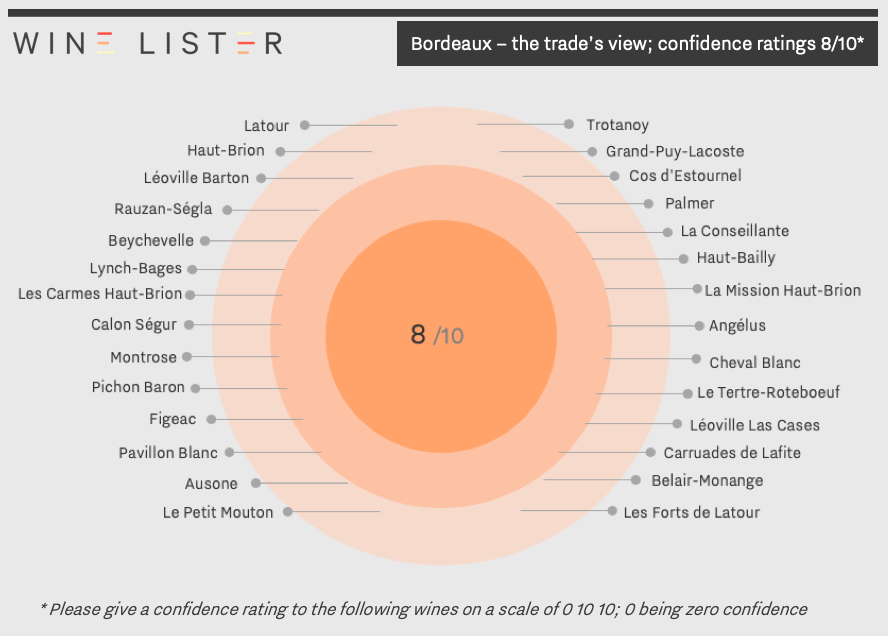
Though Margaux’s Pavillon Rouge moves down to a rating of 7/10 in 2020, three younger siblings of first growths stay at a rating of 8/10: Carruades de Lafite, Le Petit Mouton, and Les Forts de Latour.
Part II of the Bordeaux 2020 study, including a score breakdown of 2019s, and further retrospective analysis of the en primeur campaign, will be published shortly. Watch this space.
In the meantime, visit the Analysis page to purchase Part I, or download using your Pro subscription (available in both English and French).
The final stretch of en primeur releases came yesterday – Tuesday 23rd June (excepting Petrus and Le Pin, which are generally always released at the end of the campaign).
First out of the blocks was the en primeur darling, Les Carmes Haut-Brion. Wine Lister’s CEO, Ella Lister, believes Director, Guillaume Pouthier and his team have produced another stunning effort in 2019, continuing their streak of achieving consistently high scores from critics since the 2014 vintage. She names the wine “heady” and “hypnotising” with aromas of “dark fruit, graphite, and mature roses” on the nose. On the palate she describes the wine as “silky, seductive, and generous”, adding that it is “incredibly pure”.
Aside from Les Carmes Haut-Brion’s clear qualitative success, the additional factors of its small production levels and smart en primeur pricing once again make it one of the most obvious buys of the campaign. One top UK merchant tells me, “we sold out in a matter of seconds”. The bittersweet irony of its huge demand is, of course, that it is reserved only for the lucky few. Indeed, its popularity has soared since the release of the 2016 vintage, which has more than doubled its price since. Its impressive price performance post en primeur release (the 2019 released at £58, 28% below the current price of the 2018) is the cherry on Bordeaux buyers’ favourite cake – Les Carmes Haut-Brion is, perhaps unsurprisingly, the number one Bordeaux wine voted by the trade to have seen the sharpest rise in demand, as shown in the chart below.
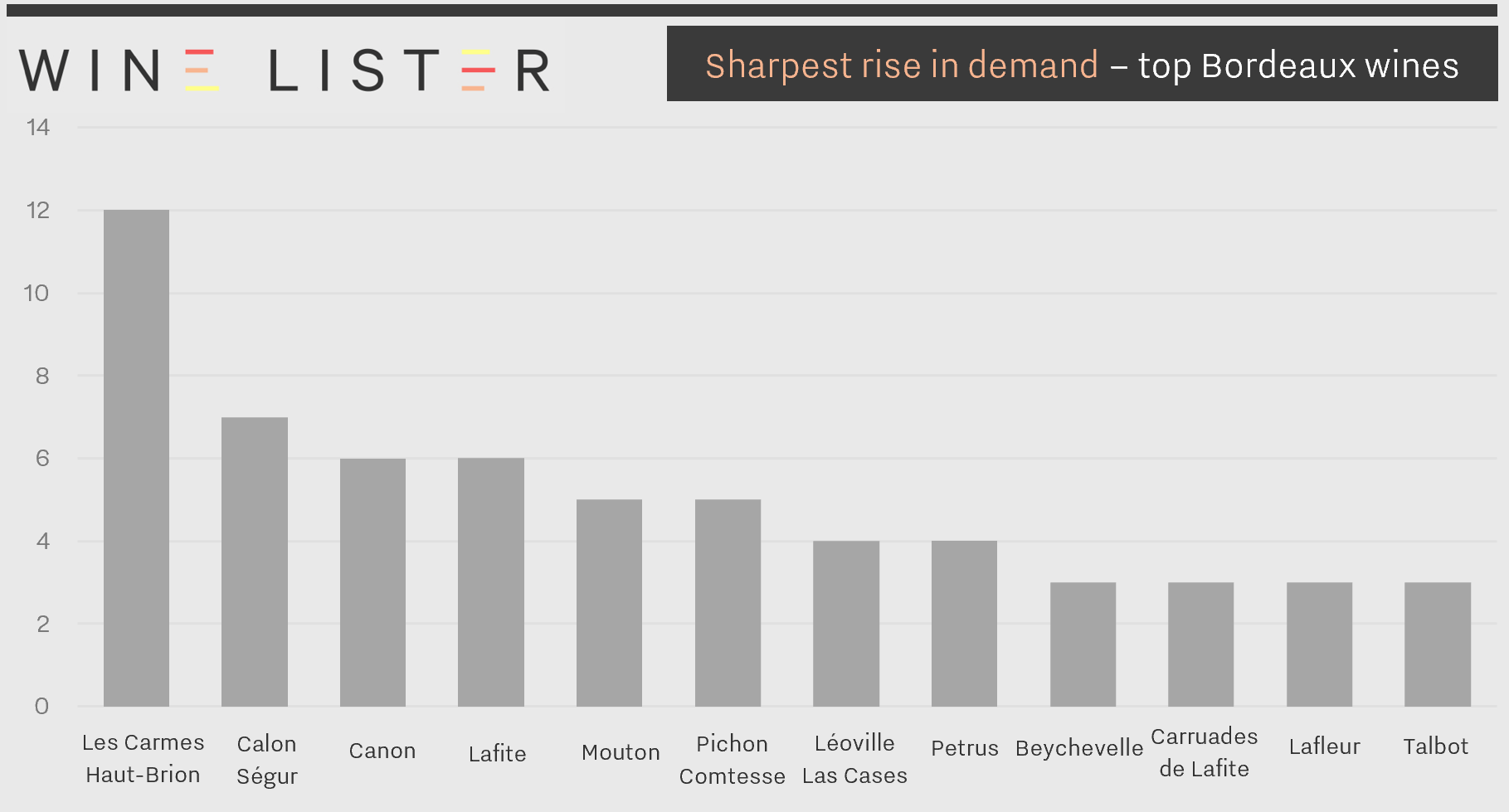 Results from Wine Lister’s 2020 trade survey show Les Carmes Haut-Brion achieves first place for sharpest rise in demand of Bordeaux wines.
Results from Wine Lister’s 2020 trade survey show Les Carmes Haut-Brion achieves first place for sharpest rise in demand of Bordeaux wines.
Joining the fray of hot ticket releases from yesterday was Vieux Château Certan. Wine Lister partner critics were collectively impressed with the 2019, placing its quality on par with the 2018 (which achieves a WL score of 96). Writing for JancisRobinson.com, James Lawther describes the 2019 as a “classic VCC”, while Neal Martin for Vinous hails it a “brilliant follow-up to the 2018”. Releasing at £177 per bottle (in-bond), the latest vintage comes onto the market 20% below the current market price of the 2018.
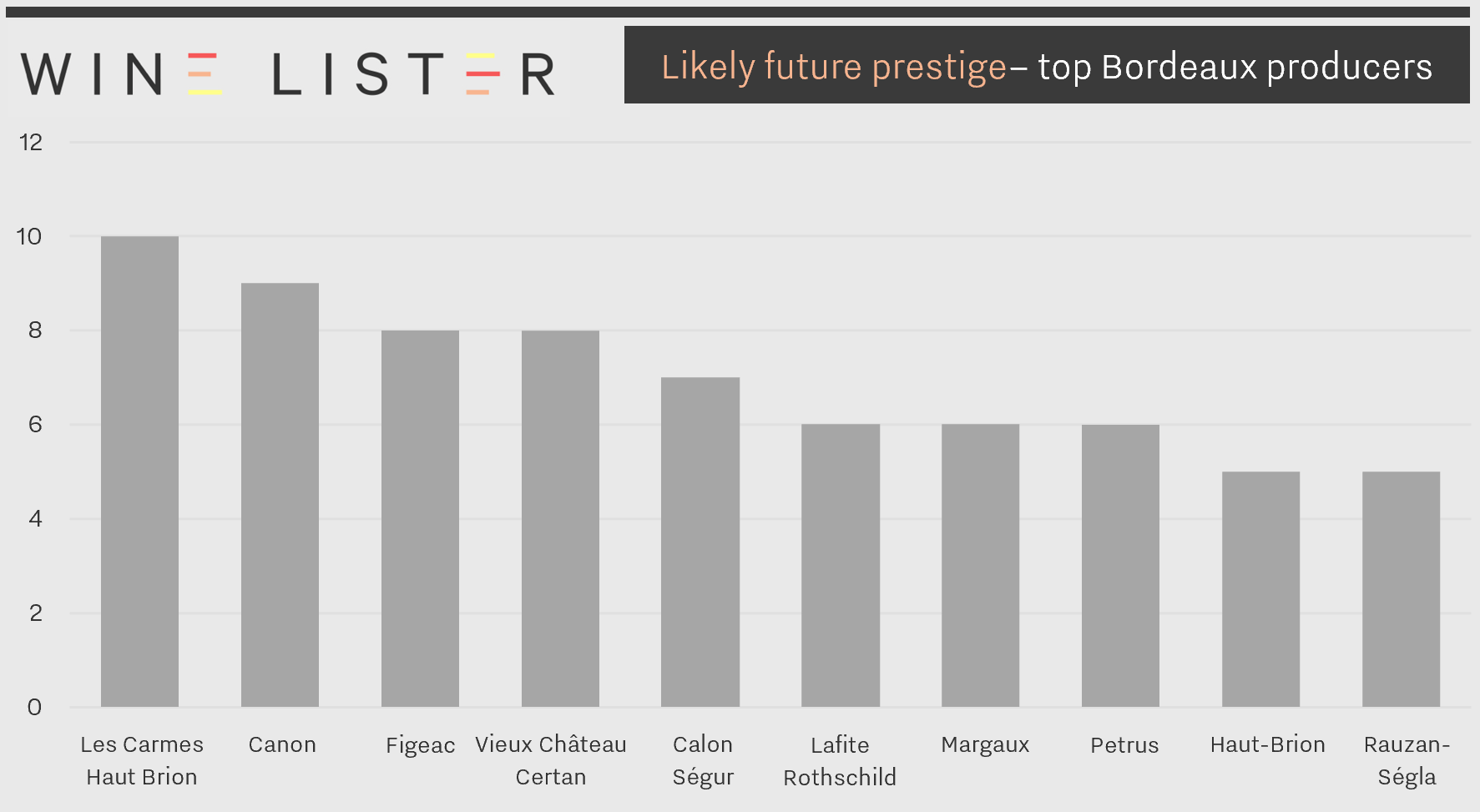 Four releases from Tuesday 23rd June land within the top 10 Bordeaux wines to be voted by key members of the trade as most likely to see future prestige – Les Carmes Haut-Brion, Vieux Château Certan, Canon, and Rauzan-Ségla.
Four releases from Tuesday 23rd June land within the top 10 Bordeaux wines to be voted by key members of the trade as most likely to see future prestige – Les Carmes Haut-Brion, Vieux Château Certan, Canon, and Rauzan-Ségla.
Chanel siblings Canon and Rauzan-Ségla also released their 2019s onto the market yesterday, adding weight to a day full of releases set for bright futures (see image above).
Saint-Émilion star, Canon, released its 2019 to the market at £73 per bottle (in-bond) – 23% below current prices of the 2018 and 2016 vintages. The Canon team characterise 2019 as a “metronome” vintage, referring presumably to the swinging back and forth between climatic extremes. The wet spring and the risk of frost, followed by the strong heat of the summer resulted finally in a perfect finish to the vineyard cycle at the time of harvest, and a wine that sings at perfect pitch. Lister describes Canon 2019 as a “sweet, seductive temptress”, with “voluptuous, racy acidity”, which Director Nicolas Audebert tells us, “2019 is a combination of 2015 and 2016”.
Canon’s Margaux sister, Rauzan-Ségla, also joined the stage, at £57 per bottle (in-bond). A “luscious”, and “lithe” wine, Lister notes the 2019 has “melting fruit, from red to black and back”, and a “toasty, flirty, refined length”. Entering the market 34% below the current price of the 2018 vintage, and offering the second most generous discount on 2018 market prices of the entire campaign (behind only Lafleur), this is sure to see high levels of demand.
 A different time – a throwback to 2018 and a celebration at Château Berliquet, of its acquisition by the Chanel group.
A different time – a throwback to 2018 and a celebration at Château Berliquet, of its acquisition by the Chanel group.
The Chanel group’s new baby, Berliquet, is also growing up fast, releasing its 2019 at £34 per bottle (in-bond). Lister describes “ripe, juicy strawberries” on the nose, adding that it is “very complete, accomplished, and reassuring, with a mineral lift”. On the palate, she finds Berliquet 2019 “rich, full, but very clean-lined”, with “lovely acidity which brings out definition on the finish”. Judging by the immense success of its big siblings, Berliquet has a bright future ahead, and the 2019 is worth snapping up.
Also released yesterday were: Beau-Séjour Bécot and Beauséjour Héritiers Duffau Lagarosse
As we approach the tail end of this busy campaign, the last two working days have seen some promising releases from both banks. Below we examine some of the highlights.
Friday 19th June
Haut-Bailly 2019 was released at £70 per bottle (in-bond), 20% below the 2018 release price. Wine Lister partner critics collectively award the 2019 its highest WL score ever (96), with laudable comments to boot – Antonio Galloni states, “it is easily one of the highlights of the vintage”, while Wine Lister’s CEO, Ella Lister, finds the wine “dark fruited and brooding”, on the nose, and “bewitching, languorous, and layered” on the palate. Haut-Bailly 2019 places second of all Pessac-Léognan reds, after a joint-first WL score of 97 for La Mission Haut-Brion 2019 and Haut-Brion 2019). With a record-high quality, and as a brand on the up, this is a release not to be missed.
Also released on Friday were wines from the Las Cases stable. The flagship wine, Léoville Las Cases, came onto the market at £145.50 per bottle (in-bond) – also a 20% discount from 2018’s opening price. Tasting in Bordeaux two weeks ago, Lister notes the 2019 is “magisterial” with “building power on the finish”. Wine Lister partner critic, Neal Martin, awards Léoville Las Cases 2019 96-98 points, and adds, “there is a clarity to this Grand Vin that places it amongst Jean-Hubert Delon’s finest releases in recent years”.
 Picnic with Director Pierre Graffeuille – Wine Lister’s CEO, Ella Lister, tasted the Las Cases 2019s in Bordeaux two weeks ago, and describes the Grand Vin as “Luminous, transparent, and lyrical”.
Picnic with Director Pierre Graffeuille – Wine Lister’s CEO, Ella Lister, tasted the Las Cases 2019s in Bordeaux two weeks ago, and describes the Grand Vin as “Luminous, transparent, and lyrical”.
Clos du Marquis and Nénin were also released, each offering good value in the context of similar quality wines produced in their respective appellations – Saint-Julien and Pomerol. Léoville Las Cases’ little brother, Petit Lion, is also exceptionally good value.
Perhaps the most notable release of a very busy Friday was l’Église Clinet 2019. Coming onto the market around the same price as the 2018 at £214 per bottle (in-bond), this is a sure exception to the trade’s “-30%” rule, given its circumstances – the last vintage of owner, the late Denis Durantou, who sadly passed away one month ago. Critics’ scores suggest that this final vintage was his best yet – Neal Martin awards it 97-99 points, and notes, “the perfect way to remember and raise a toast to one of Pomerol’s finest vignerons”. For Thierry Desseauve, l’Église Clinet is one of the wines of the vintage.
Pavie Macquin and Larcis Ducasse also released their 2019s on Friday. The former was one of Lister’s stand-out wines in 2019. She describes it as “bright and self-assured” on the nose, and “juicy and unctuous” on the palate. The latter shows particularly well against the wider Saint-Émilion backdrop. Saint-Émilion Grand Cru Classé “B” Larcis Ducasse 2019 earns a WL score of 95 – one point less than the likes of Cheval Blanc and Pavie, and is priced at just £47 per bottle (in-bond), or an average six times less than its Classés “A” comrades.
Monday 22nd June
Pichon Comtesse made for a powerful kick-off to the Bordeaux 2019 en primeur campaign’s fourth (and possibly final) week. Releasing at £111 per bottle, the latest vintage comes onto the market c.15% below the 2018 and 2016 vintages, if at a c.10% premium to the highly-scored 2015. Wine collectors will nonetheless likely be desperate to get their hands on this, given its resounding praise from critics, not to mention the impressive popularity of the estate. A perennial Wine Lister favourite, CEO, Ella Lister notes the wine has “perfectly poised fruit, interwoven with savoury complexity”. Neal Martin awards Pichon Comtesse 2019 98-100 points, and says, “Whisper it…it reminds me of their First Growth next door neighbour”. Dare we say it – this is Latour-level quality for roughly a quarter of the price.
Also released today is Saint-Émilion superstar, Troplong-Mondot. Its 2019 comes onto the market comfortably below the preceding four vintages on the market, with a price of £63.50 per bottle. Continuing the impressive quality increase and style evolution lead by Aymeric de Gironde and his team, critics are impressed with Troplong-Mondot 2019. Antonio Galloni states, “this is a wine that simply can’t be denied”, and Neal Martin agrees, adding that it is “just a wine you are going to want to drink”.
Further releases from Friday 19th June and Monday 22nd June are: Lascombes, Potensac, Réserve de la Comtesse, Smith Haut Lafitte, and Smith Haut Lafitte Blanc.
The second half of this week has seen releases from first growth Margaux, Super-seconds Pichon Baron, Ducru-Beaucaillou, and more.
The two highest-priced wines released over the last two days have bucked discount trends set by their peers earlier in the campaign. Ausone 2019 was released on Wednesday 17th June, and merchants have been offering the wine for c.£432 per bottle in-bond (or 22% less than the 2018 vintage). Earlier in the campaign, Saint-Emilion Grand Cru Classé “A” neighbour, Cheval Blanc offered a healthier discount on its 2019 (of 32%), resulting in the competitive price of £375 per bottle.
Similarly, the last first growth of the campaign emerged yesterday, its grand vin entering the market at £350 per bottle. Margaux 2019 offers a 16% discount on last year’s release price. Sitting more or less in the middle of 2019 prices from its two Pauillac comrades, Margaux nonetheless looks good when one considers Managing Director Philippe Bascaules’ poignant comment, naming the 2019 “much more Château Margaux” than the 2018. The 2019 also achieves Margaux’s best WL score (98 points) since the 2009 vintage. Volumes released onto the market are identical to last year, which will no doubt help to gain further appeal from buyers missing out on Lafite and Mouton.
Margaux’s second wine, Pavillon Rouge, and dry white, Pavillon Blanc were also released, at £125 and £168 per bottle (in-bond) respectively.
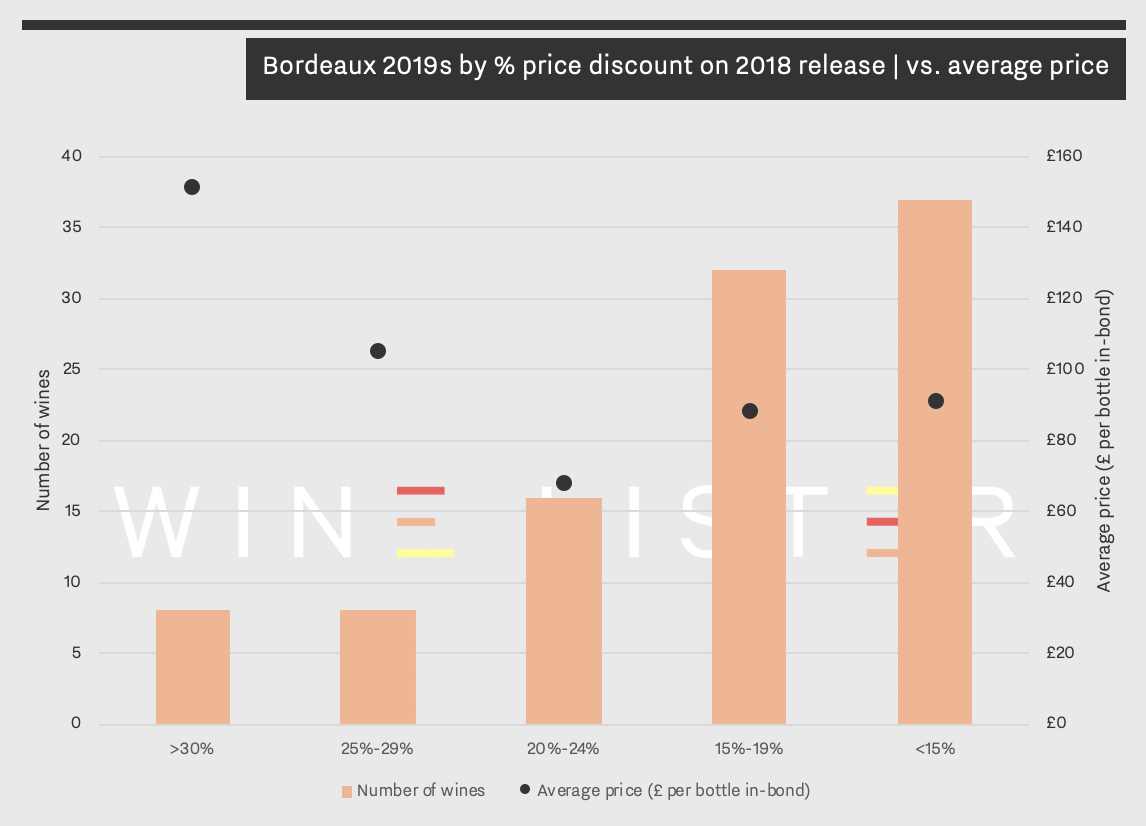 Of the c.100 wines released so far that Wine Lister covers, just eight of them have provided a 30% discount or above on 2018’s release price, while almost 40 wines have offered discounts of less than 15%.
Of the c.100 wines released so far that Wine Lister covers, just eight of them have provided a 30% discount or above on 2018’s release price, while almost 40 wines have offered discounts of less than 15%.
Pauillac powerhouse Pichon Baron also entered the market with its 2019 at £99 per bottle (15% below the current market price of 2018). Wine Lister partner critic, Neal Martin, awards it 96-98 points, simply saying, “this is an outstanding Pauillac”. The same score was given by Martin to Saint-Julien super-second, Ducru-Beaucaillou, which also released yesterday. While both 2019 releases will no doubt find homes among followers of the brands and big en primeur buyers, in each case a recent back vintage also looks appealing in comparison – the 2015 Pichon Baron, and 2014 Ducru-Beaucaillou.
The Barton family wines joined the release fray this week – Léoville Barton, Langoa Barton, and value buy Mauvesin Barton. Wine Lister partner critics give high praise to the flagship release – Léoville Barton. Neal Martin and Antonio Galloni both award it 94-96 points, the latter saying, “what a gorgeous wine the 2019 is”. Together with James Lawther’s score of 18/20 for JancisRobinson.com, Léoville Barton 2019 achieves its highest Wine Lister score since the 2015 (95 points), which still has some availability in the market at around the same price.
Brane-Cantenac released yesterday at £41.50 per bottle. Its 2018 was one of Wine Lister’s absolute favourites during last year’s en primeur tastings, and judging by the latest critical acclaim, the 2019 has achieved another quality step up – James Lawther gives it 17.5 points, and names it “the epitome of fine Margaux”. This wine continues to provide excellent value when compared to similar quality offerings of its appellation.
La Lagune 2019 also entered the market, at £25 per bottle (in-bond). Having produced no wine in 2018, the latest release is priced 19% below the 2017, and is the cheapest recent vintage available on the market. Neal Martin awards it 92-94 points, naming the wine “not impactful, but intellectual”, and noting it will give “25-30 years of drinking pleasure”. With a potential record-level quality at such an attractive price, La Lagune could be the value buy of the entire campaign.
A further favourite, and poster child for good value, Meyney, also released its 2019 on Wednesday. Coming onto the market under £20 per bottle, and as the cheapest Meyney available, the wine is a no-brainer, as it continues to punch above its weight for quality.
Also released on Wednesday 17th and Thursday 18th June were: Canon-la-Gaffelière, Chapelle d’Ausone, Clinet, Clos de l’Oratoire, Croix de Beaucaillou, d’Aiguilhe, and La Mondotte.
Since the last update, some 34 further Bordeaux 2019s have been released en primeur, covering a wide range of styles and price points. Given the saturation of releases, below we highlight a small selection of wines particularly worth backing.
Big hitters
La Conseillante opened the stage of en primeur week three – “mega Monday”, releasing its 2019 at £126 per bottle. Wine Lister’s CEO, Ella Lister, notes the wine is “vibrant, with a playful bouquet of spice, tobacco, and pure dark fruit”. Wine Lister partner critic, Neal Martin agrees, awarding the 2019 its highest ever Vinous score (97-99), and noting, “Winemaker Marielle Cazaux and her team have conjured a magnificent Pomerol here”. Coming onto the market 25% below 2018’s release price, this is worth snapping up given its continuation of La Conseillante’s style evolution – indeed, the wine still provides good value when compared to other Pomerols of similar quality.
Figeac followed closely behind, releasing its 2019 at an identical price. Also entering the market 25% below the 2018 (the most expensive recent Figeac vintage on the market), it too continues its upward quality trajectory in spectacular fashion. Awarding it the same score as La Conseillante, Martin names it “a deeply impressive, intellectual Figeac…amongst the canon of greats that stretch back to the 1940s”. Figeac was a Wine Lister favourite in 2018, and has clearly done another spectacular job this year – this is an absolute buy to put away for the future.
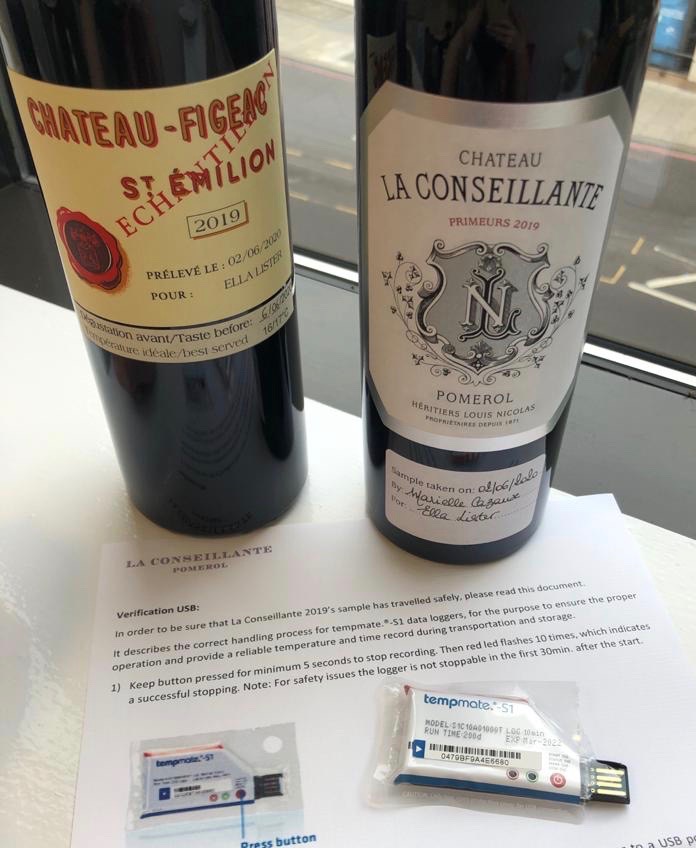
Arriving with a clever digital temperature checker – Wine Lister CEO, Ella Lister, tastes La Conseillante and Figeac samples in London.
Montrose 2019 was released this morning (Tuesday 16th June), at just over £100 per bottle (in-bond). While the wine has not yet been widely rated, Ella Lister tasted at the property last week, and names the 2019 “very harmonious, calming, and hypnotic”, with a “lovely, rounded, succulent, fresh-fruit palate”, and “satin tannins”. Continuing Montrose’s legacy of quality excellence, the 2019 is once again a good punt for decadent Bordeaux drinkers.
Old Faithfuls
Giscours 2019 released at £35.20 per bottle (in-bond) on Friday 12th June. Entering the market below current prices of the last five vintages, this should be an obvious buy for fans of the Margaux château. Lister notes the 2019 as “confident and precise” on the nose, and “creamy, accomplished, and long” in the mouth, calling it a “classic Giscours”. Neal Martin, concurs, noting, “this is a superb, potentially long-term Giscours”.
A perennial British favourite, Talbot 2019 has also been released, at an opening price of £35.15 per bottle (in-bond). Lister names Talbot 2019 one of her “coups de coeur”, adding that it is “spicy and exotic”, as well as “fresh and harmonious”. Talbot’s strong brand and visible recent quality improvements make this release a safe bet for any buyer looking for Left Bank Bordeaux to drink in 20-30 years.
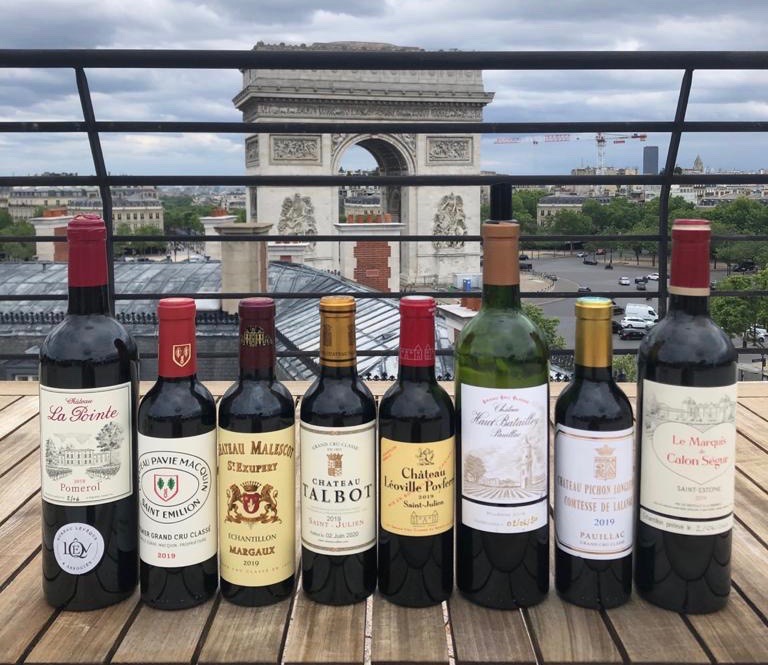 A “grand merci” to négociant Duclot for hosting the recent Bordeaux 2019 en primeur tasting in Paris. Pictured: some of Wine Lister’s CEO, Ella Lister’s favourites.
A “grand merci” to négociant Duclot for hosting the recent Bordeaux 2019 en primeur tasting in Paris. Pictured: some of Wine Lister’s CEO, Ella Lister’s favourites.
Grand-Puy-Lacoste released its 2019 this morning (Tuesday 16th June), at £45 per bottle (in-bond). Another UK favourite, this release has seen some buzz from those trade members who have tasted already, and critics agree – Lister writes that it is “blue fruited, aquiline, pure, and purring”, while Martin (who gives it its best ever score – 95-97), says, “Classy and full of breeding – quintessential Pauillac”. Despite some availability of recent back vintages – 2015 and 2014 – at a similar price (or indeed cheaper), this is still a solid bet for top-quality Pauillac to lay down for the future.
Value buys
Chasse-Spleen, a traditional value hit among claret buyers, released its 2019 on Friday 12th June. It enters the market at £20 per bottle (in-bond), a neat 30% below the current market price of the 2018. Neal Martin awards the 2019 a score of 92-94 – placing its quality in line with the 2016 (93 points), with the potential for it to become even better in the future.
Lafon-Rochet released its 2019 yesterday, at £28.30, 12% below the current market price of the 2018. Neal Martin’s score of 93-95 suggests the Saint-Estèphe property has made another quality step up in 2019. Martin notes, “it is imbued with a sense of nobility and classicism that I much admire”. While the “discount” on 2018’s release price is not as high as some may have wished for, Lafon-Rochet 2019 still looks like a bargain relative to other Left Bank wines of similar quality.
Gloria 2019 was released this morning, at £25.10 per bottle (in bond). While only 13% below the current market price of the 2018, the 2019 still provides excellent value relative to other Saint-Julien wines, particularly considering its quality in 2019. Neal Martin awards it 93-95 points, and says, “this is a nimble Saint-Julien, athletic in build with a sapid finish that urges you back for another sip. Excellent”.
Also released over the last few days are the following 2019s: Beauregard, Blason d’Issan, Certan de May, Connétable de Talbot, d’Issan, de Sales, du Tertre, Feytit-Clinet, Fourcas Hosten, Grand Corbin-Despagne, Gruaud-Larose, La Dame de Montrose, La Fleur-Pétrus, La Pointe, La Violette, Lacoste Borie, Lagrange, Le Gay, Les Cruzelles, Montviel, Pape Clément, Pape Clément Blanc, Prieuré-Lichine, Sarget de Gruaud-Larose, and Saint-Pierre.
Today is the 12th working day since the first major 2019 en primeur release, and over 60 wines are already out.
Among others, the last couple of days have seen the 2019 release of another first growth, a Pauillac powerhouse brand, and a major up-and-comer.
Haut-Brion released its red and white grands vins yesterday, at £295 and £560 per bottle in-bond respectively. While the red enters the market a solid 25% below the current market price of the 2018, the white is the campaign’s most expensive wine yet, and offers a smaller discount, of 5% on 2018.
Following Mouton Rothschild’s lead, Haut-Brion’s red looks well-priced within the current economic context, though buyers may note that the 2014 is available on the market around the same price. The 2012 also looks good – earning a WL score of 96, it is a Wine Lister MUST BUY (and available for c.£260 per bottle in-bond).
Also released from the Clarence Dillon family are Haut-Brion’s baby brother, Le Clarence (at c.£100 per bottle in-bond), and cousins La Mission Haut-Brion red and white. Of the two flagship reds, Haut-Brion is likely the stronger horse to back, based on its first growth status, as well as its position according to the trade among top Bordeaux wines for future prestige (see below).
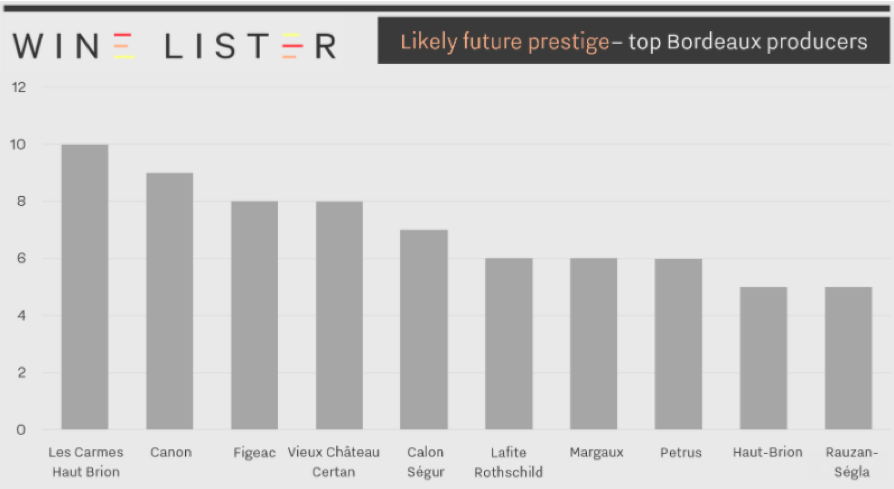 According to Wine Lister’s 2020 trade survey, Haut-Brion is one of top Bordeaux wines most likely to be worth including in collectors’ future cellars.
According to Wine Lister’s 2020 trade survey, Haut-Brion is one of top Bordeaux wines most likely to be worth including in collectors’ future cellars.
Three further pairs of releases from Pessac-Léognan have emerged over the last two days, comprising Malartic-Lagravière, Latour-Martillac, and Carbonnieux.
On Thursday 10th June, Pauillac star-brand Lynch Bages was released, and has resulted in an onward UK selling price of c.£66 per bottle in-bond. Wine Lister’s CEO, Ella Lister, tasted it last week, and found it to be “lifted, precise”, and “a classic”. The price positioning under £70 has reportedly been well-received.
Haut-Batailley was also introduced to the market, at £36 per bottle in-bond. As its second en primeur release under Cazes ownership (the same family as Lynch Bages), the 2019 is 20% under the current market price of the 2018. Following a repositioning of Haut-Batailley’s pricing during en primeur last year, the 2019 release looks good value – the wine’s strong reputation will likely only become stronger with a new wave of investment, and prices are likely to rise accordingly. Lister describes Haut-Batailley 2019 as “pretty”, “elegant”, and “very harmonious”, with a “long, saline, dark chocolate finish” – this is a wine to buy now.
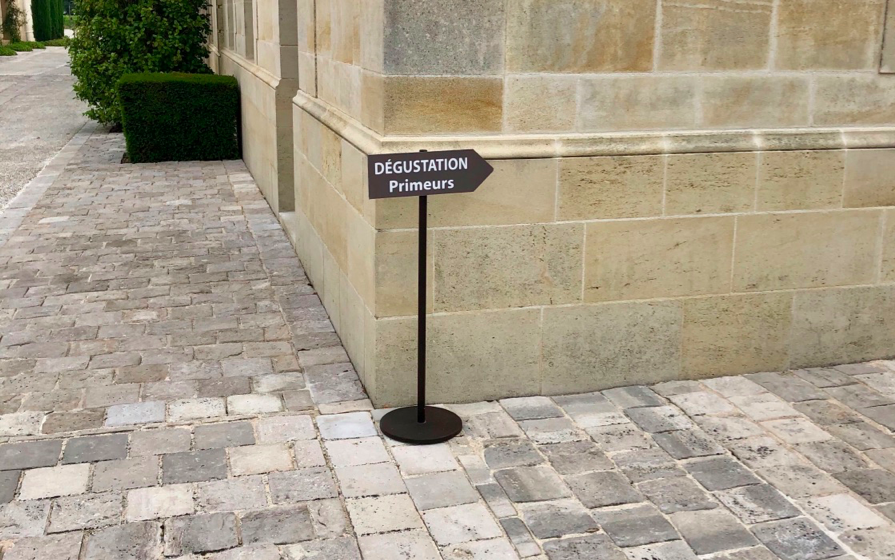 Better late than never – Wine Lister’s CEO, Ella Lister, has now tasted the majority of Bordeaux 2019s. Watch this space for her favourites, and Bordeaux 2019 MUST BUYs coming soon.
Better late than never – Wine Lister’s CEO, Ella Lister, has now tasted the majority of Bordeaux 2019s. Watch this space for her favourites, and Bordeaux 2019 MUST BUYs coming soon.
One further release for each side of the river caught Wine Lister’s eye this week: La Gaffelière 2019 was released 13% beneath the current 2018 market price. The château’s director, Thomas Soubes, told Wine Lister that he was very happy with the quality of their 2019, and Lister concurs – she finds the wine “serious” and “charming”, with “velvet tannin” and “seductive red fruit”. La Gaffelière continues to present excellent value for its impressive quality, relative to wines sharing the Saint-Emilion Grand Cru Classé “B” classification.
Calon Ségur 2019 was also released yesterday. As one of the top rising stars of Bordeaux, its 2019 came onto the market 10% below the 2018 release price, but crucially 31% below 2018’s current market price. Calon Ségur is one of the “poster children” for the true benefits of buying en primeur. Lister found Calon Ségur 2019 to be “perfumed”, “juicy”, and “unctuous”, with “spice on the mid-palate” and a “saline, super-precise finish”. As ever, this is worth snapping up before its price inevitably increases post en primeur release.
Also released during the same period were: Cantenac-Brown, Capbern, Clos Fourtet, Clos René, Cos Labory, Kirwan, Monbousquet, Moulin Saint-Georges, Pavie, Phélan Ségur, Pibran, and Suduiraut.
Keep up to date with further Bordeaux 2019 en primeur releases through Wine Lister’s dedicated en primeur page.
Now into its second full week, the Bordeaux 2019 en primeur campaign shifted up another gear today, with the release of first growth Mouton Rothschild, and its associated properties.
After the flurry of releases yesterday (Monday 8th June) met with very mixed reviews, Mouton reset the campaign tone, with a price 30% below the current market price of 2018, and under the price of all recent back vintages. Bordeaux buyers no doubt breathed a sigh of relief at the tidy figure – £299 per bottle in-bond – the most obvious buy of the campaign so far (other than Lafleur).
Not only is this release on the money in recognising today’s difficult economic context, as well as Bordeaux’s recent price performance struggles, it also provides a brilliant deal given the reported quality of 2019. Wine Lister’s Founder and CEO, Ella Lister found Mouton 2019 to be floral, elegant, and stately. With a high proportion of Cabernet Sauvignon (90%, vs. an average 83%) it promises a long, prosperous life ahead.
Mouton’s younger sibling, also released this morning, looks equally appealing, if for different reasons. Petit Mouton is one of Bordeaux’s top wines for long-term price performance, and its 2019 release price thus manages to enter the market well under all recent back vintages.
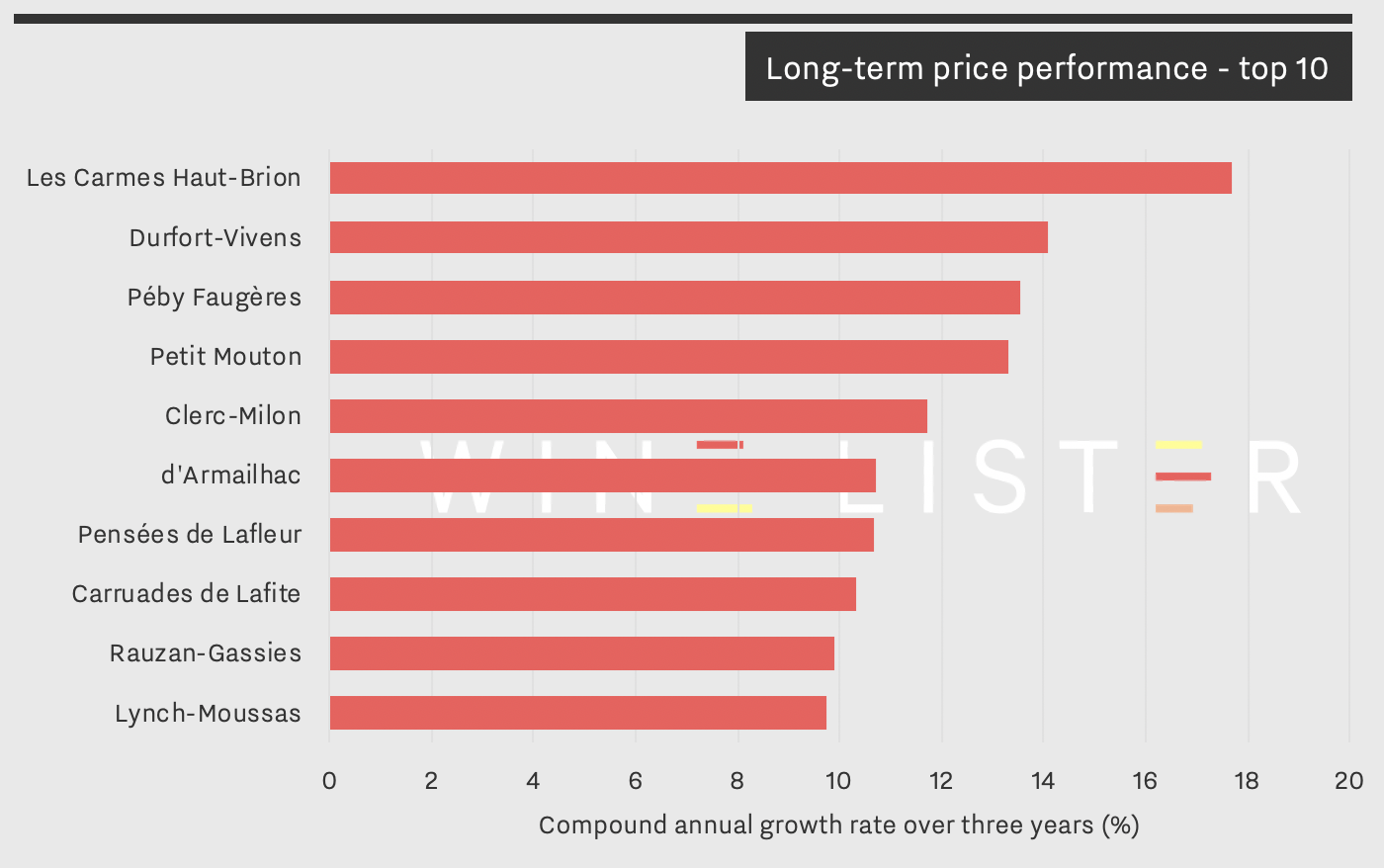 Of major Bordeaux brands, Petit Mouton achieves an average three-year CAGR (compound annual growth rate) of 13.3%, placing it in fourth place of the top 10 long-term price performers, as shown above.
Of major Bordeaux brands, Petit Mouton achieves an average three-year CAGR (compound annual growth rate) of 13.3%, placing it in fourth place of the top 10 long-term price performers, as shown above.
The other 2019s in the Mouton stable, d’Armailhac, Clerc-Milon, and Aile d’Argent were also released today, at prices (per bottle, in-bond) of £31, £52, and £60 respectively.
Yesterday’s hot ticket was right-bank royalty, Cheval Blanc, whose release at £375 also offered consumers a substantial discount on the 2018 release price (32%). Though not yet scored widely by critics, using 2018 as a proxy would mean Cheval Blanc 2019 achieves its joint-highest WL score since the 1961 (alongside the likes of recent greats – 2016, 2015, 2010, 2009, and 2005).
Fellow Saint-Émilion Grand Cru Classé A, Angélus, also released yesterday, though its release price in line with the physically available 2015 perhaps makes it look less attractive. There is nonetheless a real step-change in style and quality happening at Angélus, pioneered by the de Bouärd father-daughter team (Hubert and Stéphanie), which could mean this release is worth investing in for the future.
Two further releases of note from yesterday both hail from Saint-Julien. Branaire-Ducru, a Wine Lister favourite, released its 2019 at £29 per bottle in-bond, 25% down on the 2018 release price. Assuming Branaire’s 2019 is on par with 2018 quality, this is an absolute buy, as the estate’s joint best-ever grand vin at a price beneath all other recent vintages on the market. Léoville-Poyferré 2019 was also released, at £51.34 per bottle in-bond. Offering a 25% discount on last year’s release price for the same quality level, the Saint-Julien second growth is worth considering – having tasted it last week, Lister notes that it is “super-fresh, scented, and luscious”.
Also released so far this week are: Beychevelle, Carillon d’Angélus, Coutet, Gazin, Haut-Bages Libéral, Ferrière, La Gurgue, La Tour Carnet, Larrivet Haut-Brion red and white, and Petit Cheval.
As the first major week of Bordeaux 2019 en primeur releases draws to a close, this morning (Friday 5th June) saw the release of the “first of the Firsts”, and the other reds from the Lafite stable.
Carruades de Lafite 2019 opened the stage with a price of £158 per bottle (in-bond), making it the least expensive Carruades available on the market. The Wine Lister team felt the quality of Carruades saw a significant jump up in 2018, and from what we have heard, the 2019 matches it. With this in mind, and given that volume released onto the market is 50% less than last year, this is a sure buy for anyone seeking access to the Lafite prestige with more approachability.
The grand vin, Lafite 2019, has been released at £426 per bottle in-bond – a discount of c.20% on the 2018’s current market price. The crucial factor this year are the volumes available – also 50% less than last year. On top of this, the single tranche released means buyers will only have one shot to get their hands on the 2019 en primeur (as far as we know). Domaines Baron de Rothschild’s Commercial Director, Jean-Sébastien Philippe, calls Lafite a “modern classic” in 2019, with precision, length, and finesse, but impressive ripeness, making it more approachable than the likes of 2018 or 2016.
Both Lafite and Carruades were cited by the trade as seeing sharp rises in demand (see below) according to Wine Lister’s 2020 Founding Members’ survey. Competition to access both of these wines will therefore likely be high.

Lafite’s Pomerol property, L’Evangile, has released its 2019 grand vin at £146 per bottle in-bond, 15% below the current market price of the 2018. Once again, the Wine Lister team noticed a distinct quality step up in Evangile’s 2018, which we’ve heard has been equalled in 2019. The 2019 reportedly expresses well the move towards a more modern style, and a wine of increasing tension, florality, and freshness, without losing the plush Pomerol profile.
Duhart-Milon 2019 has also been released, at £52 per bottle in-bond. Though the release price puts it more or less in line with market prices of back vintages 2018 and 2016, there is justification to be found in the excellent quality that the Lafite team believe is there in 2019. Philippe explains that Duhart-Milon’s vines sit on a cooler terroir than those of the estate’s Pauillac neighbours, which means in cooler vintages, the wine can be somewhat “austere”. The increasing average temperatures that Bordeaux has seen during recent growing seasons (2018, 2016, and 2015 vintages) therefore only serve to improve the quality of Duhart-Milon, and 2019 certainly had its fair share of heat.
Keep up to date with further Bordeaux 2019 en primeur releases through Wine Lister’s twitter, or through our dedicated en primeur page.
This week has seen a flurry of further 2019 en primeur releases, including the likes of Palmer, Cos d’Estournel, and Domaine de Chevalier’s red and white.
Released this morning (Thursday 4th June) are wines from the Guinaudeau family, including one of the most in-demand wines from Bordeaux, Château Lafleur. Lafleur 2019 is available (for the lucky few who can get their hands on it) for c.£1,550 per 3 pack case in-bond – the same release price as in 2018. While this goes against the 30%-35% discount on last year’s prices that the trade believe may just make the 2019 campaign a success across the board, Lafleur is one of the few exceptions to this rule.
Aside from its impressive and consistent quality, Lafleur boasts one of the smallest-sized estates (4.5ha) for any top Bordeaux property. With rarity on its side, the grand vin is the number one performer for price appreciation after en primeur release.

The chart above shows the top five Bordeaux wines for average percentage increase of the last three vintages – 2018, 2017, and 2016, since their respective releases. The last three releases of Lafleur have seen an average market price increase to date of 43% – 9% more than Petrus.
Perhaps also contributing to the popularity of the Guinaudeau family’s wines is their more “Burgundian” approach to winemaking, with vineyards planted on three separate plots of very different soil types, and the final products aiming to reflect these differences.
For those unable to achieve the dizzy heights of an allocation of the grand vin, the estate’s Perrières de Lafleur (available for £256 per 6-pack in-bond for the just-released 2019 vintage) does exactly this, typically showing mineral, chalky notes from its limestone terroir. Perrières de Lafleur was officially “born” last year, after 15 years of research and testing under the wine’s beta pseudonym, “Acte”.
Finally, at the opposite end of the price spectrum to the flagship wine is Grand Village – the family’s Bordeaux Supérieur, whose quality has come on leaps and bounds over the last few vintages. Grand Village is a Value Pick in every single vintage listed on Wine Lister (2018-2013). If the 2019 is anywhere near the quality of last year, it will surely offer the same impressive quality-to-price ratio.
Follow Bordeaux 2019 en primeur releases through Wine Lister’s twitter, or through our dedicated en primeur page.
Wine Lister is a big fan of Bordeaux – the city, the people, the wines (of course), and we even have a soft spot for its idiosyncratic system for selling wines. This year has thrown us, as we learn about the 2019 vintage from our desks, confined to our homes, rather than out on the “Médoc highway” or between the walled roads of the right bank.
 Virtual tasting – Wine Lister’s Founder & CEO, Ella Lister, tastes the Baron Philippe de Rothschild 2019s with Philippe Sereys de Rothschild and Managing Director, Philippe Dhalluin.
Virtual tasting – Wine Lister’s Founder & CEO, Ella Lister, tastes the Baron Philippe de Rothschild 2019s with Philippe Sereys de Rothschild and Managing Director, Philippe Dhalluin.
From what we have heard and read (and from the little we have tasted so far), the 2019 vintage in quality terms is in line with recent greats – 2018, 2015, 2010, and 2009. The current global pandemic makes for an unlucky welcome party for a wine that had luck on its side all through the growing season. Climatic events for the 2019 vintage were far less extreme than for 2018 or 2017. Frost threatened, and heat waves came, but each time the majority of vineyards escaped from disaster. “There was heat, but rain each time we needed it at the precise right moment”, explains Cos d’Estournel’s owner Michel Reybier. He names his Grand Vin in 2019 “miraculous”, and adds that Cos d’Estournel Blanc is the “best white they’ve ever made”. Miracles occurred further south in the Médoc, too – Technical Director Nicolas Glumineau believes that Pichon Comtesse 2019 has finally overtaken the heights of his heretofore “hero wine”, Montrose 2010.
Many producers we have spoken to echo this sentiment, underlining the high quality of the wines made in 2019, and notably, their impressive balance. The best examples in 2019 have reportedly achieved the vinous holy grail: equilibrium between the triumvirate of flavour concentration, structure (from tannin and alcohol), and acidity, thanks in part to the “balanced” weather conditions throughout the growing season.
The winter of 2018-2019 was unusually mild, causing budbreak to occur between five days and two weeks early. While such a phenomenon might normally cause the rest of the season to be premature, including harvest, the vinous clock soon righted itself thanks to a cool spring. Bordeaux spent several nights on frost-alert from late March to mid-May. Véronique Sanders, Director of Haut Bailly tells us they lit fires in the vineyards to protect from frost on at least five occasions during the spring of 2019 – on 27th and 28th March, 13th April, and 5th and 6th May. With no frost damage, and flowering back to “normal” timing, the next challenge facing the 2019 vintage was heat. France’s south-west experienced another hot summer in 2019, but rain arrived just in time on three occasions: one in July, once in August, and then some light showers in early-mid September, bringing freshness and energy to the grapes before harvesting.
Hot and dry spells through the summer have made 2019 a Cabernet Sauvignon vintage; the grape takes up a slightly higher proportion than normal of the blend of many Grands Vins. By the same token, the cooler spells have resulted in good freshness for Merlot. Philippe Dhalluin, Managing Director at Baron Philippe de Rothschild, says that Merlot across the group’s châteaux is the best since 2010, but that the Cabernet Sauvignon is so good, that the high quality of the former will be of benefit largely to the second wines. Mouton Rothschild is made up of 90% Cabernet Sauvignon in 2019, a higher proportion than average.
2019 was lucky in volume, as well as in quality. Dhalluin tells us production volumes of the Baron Philippe stable are normal-to-generous, and he is not alone. On the right bank, Director of La Gaffelière, Thomas Soubes, says “we are lucky to have quality and quantity this year”. Where in 2018 properties across both banks were forced to triage vigorously because of mildew, and started with lower yields due to severe heat stress on the vines, 2019 evaded both of these afflictions. Also contributing to good volumes at many properties were exceedingly healthy grapes at the time of harvest. Director of Talbot, Jean-Michel Laporte explains, “thanks to the impressive health of the grapes, sorting in 2019 was purely about choosing the very best quality”. The first Merlot grapes harvested at Pichon Baron certainly seemed a hopeful sign for the liquid to come.
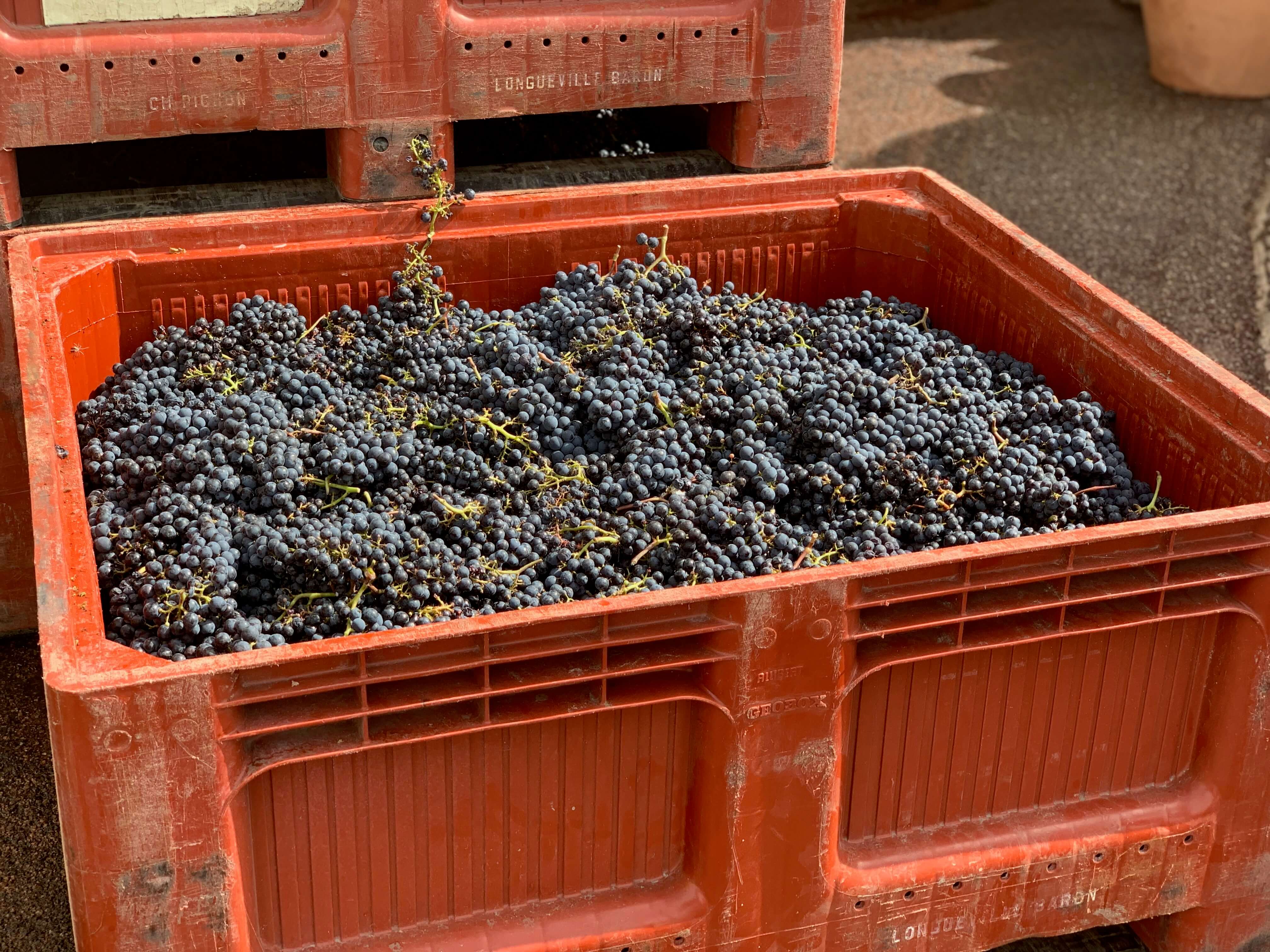 23rd September 2019 – some of the first Merlot grapes to be harvested at Pichon Baron.
23rd September 2019 – some of the first Merlot grapes to be harvested at Pichon Baron.
Though the Wine Lister team is yet to taste the majority of Bordeaux 2019s, their quality appears to be a good news story for a world on lockdown. While the current market could be considered a rather ill-fitting stage for a vintage with such qualitative promise, the releases have just begun (with Pontet-Canet the first major release). Early signs are that the Bordelais are listening, and might just reduce prices in line with the global crisis. For anyone with the headspace for en primeur in the current context, this is a campaign not to be missed.
Wine Lister looks forward to tasting more of the wines as soon as it becomes possible. In the meantime, we will be providing the usual campaign coverage, in the form of real-time release emails for Wine Lister Pro Subscribers, and Twitter alerts for all our followers, as well as live updates on our dedicated en primeur page.
A second post on Bordeaux 2019 will focus on the campaign, and discuss pricing within the unprecedented context of this year’s releases. Watch this space.


 Results from Wine Lister’s 2020 trade survey show Les Carmes Haut-Brion achieves first place for sharpest rise in demand of Bordeaux wines.
Results from Wine Lister’s 2020 trade survey show Les Carmes Haut-Brion achieves first place for sharpest rise in demand of Bordeaux wines. Four releases from Tuesday 23rd June land within the top 10 Bordeaux wines to be voted by key members of the trade as most likely to see future prestige – Les Carmes Haut-Brion, Vieux Château Certan, Canon, and Rauzan-Ségla.
Four releases from Tuesday 23rd June land within the top 10 Bordeaux wines to be voted by key members of the trade as most likely to see future prestige – Les Carmes Haut-Brion, Vieux Château Certan, Canon, and Rauzan-Ségla. A different time – a throwback to 2018 and a celebration at Château Berliquet, of its acquisition by the Chanel group.
A different time – a throwback to 2018 and a celebration at Château Berliquet, of its acquisition by the Chanel group. Picnic with Director Pierre Graffeuille – Wine Lister’s CEO, Ella Lister, tasted the Las Cases 2019s in Bordeaux two weeks ago, and describes the Grand Vin as “Luminous, transparent, and lyrical”.
Picnic with Director Pierre Graffeuille – Wine Lister’s CEO, Ella Lister, tasted the Las Cases 2019s in Bordeaux two weeks ago, and describes the Grand Vin as “Luminous, transparent, and lyrical”.

 A “grand merci” to négociant Duclot for hosting the recent Bordeaux 2019 en primeur tasting in Paris. Pictured: some of Wine Lister’s CEO, Ella Lister’s favourites.
A “grand merci” to négociant Duclot for hosting the recent Bordeaux 2019 en primeur tasting in Paris. Pictured: some of Wine Lister’s CEO, Ella Lister’s favourites.

 Of major Bordeaux brands, Petit Mouton achieves an average three-year CAGR (compound annual growth rate) of 13.3%, placing it in fourth place of the top 10 long-term price performers, as shown above.
Of major Bordeaux brands, Petit Mouton achieves an average three-year CAGR (compound annual growth rate) of 13.3%, placing it in fourth place of the top 10 long-term price performers, as shown above.

 Virtual tasting – Wine Lister’s Founder & CEO, Ella Lister, tastes the Baron Philippe de Rothschild 2019s with Philippe Sereys de Rothschild and Managing Director, Philippe Dhalluin.
Virtual tasting – Wine Lister’s Founder & CEO, Ella Lister, tastes the Baron Philippe de Rothschild 2019s with Philippe Sereys de Rothschild and Managing Director, Philippe Dhalluin. 23rd September 2019 – some of the first Merlot grapes to be harvested at Pichon Baron.
23rd September 2019 – some of the first Merlot grapes to be harvested at Pichon Baron.